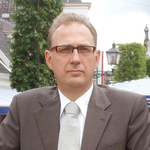
Martin Dubbeling
Participation in the activities of the Perm Forum
| April 21, 14:45-16:30 | Strategic master plan and the transformation of the city |
| April 21, 12:30-14:00 | Perm 3.0 Project in the context of russian and foreign territorial development mega projects, plenary meeting |
Biography
Martin Dubbeling (1961) is a senior consultant, urban planner and urban designer at SAB in Arnhem, The Netherlands. SAB is a multi-disciplinary office active in the fields of spatial planning, urban planning, landscape architecture and the environment in Arnhem, Amsterdam and Eindhoven in The Netherlands. Martin Dubbeling is Chair of the BNSP+NVTL Working Group on Sustainable Urban Design, Vice President of the Netherlands Professional Organisation of Urban Planning and Design (BNSP) and Vice President Urban Planning Advisory Teams (UPATs) of the International Society of City and Regional Planners (ISOCARP). For ISOCARP Martin Dubbeling is responsible for UPAT workshops in Singapore (2010), Wuhan (2012) en two in Perm (2012).
Martin Dubbeling is one of the authors of the book Sustainable Urban Design, Perspectives and Examples (2005), for which he was awarded with the Gerd Albers Award on the 42nd ISOCARP Congress in Istanbul in 2006. The second and revised edition of this book is published in September 2010. Martin Dubbeling was Rapporteur and member of the Congress Team on the 45th ISOCARP congress ‘Low Carbon Cities’ in Porto in 2009, rapporteur of the Philips Livable Cities UPAT in Singapore in 2010 and Young Planning Professionals workshop coordinator prior to the 46th ISOCARP congress ‘Sustainable City — Developing World’ in Nairobi in 2010. He has written articles about the relation between energy transition and spatial and urban planning in the ISOCARP Reviews 05 and 07.
Martin Dubbeling studied Urban Planning and Design at the Delft University of Technology
In his projects, publications and presentations, Martin Dubbeling states that sustainable urban design is urban design that focuses on people and the environment; one that can be used for a very long time and that continues to meet requirements that occur throughout time. The liveable and sustainable regions and cities of tomorrow are cities that are compact and attractive, inclusive and connected, liveable and healthy, vital and competitive. Delivering sustainable regions and cities is not just a question of technology. It also requires taking a fresh look at sustainable regional development, city values and communication with its inhabitants and its businesses.
- return_links(); ?>
-
Forum communication
-
Forum car
-
Sponsor
-
Sponsor
-
Sponsor
-
Sponsor
-
Sponsor
-
Sponsor
-
IT support
-
Sponsor
-
Sponsor
-
Sponsor
-
Sponsor
-
Sponsor
-
Sponsor
-
 Sponsor
Sponsor -
 Sponsor
Sponsor -
Sponsor
-
Sponsor
-
 Sponsor
Sponsor -
Partner
-
General media partner
-
General media partner
-
Forum TV
-
General internet partner
-
Forum online newspaper
-
Official media partner
-
Regional partner of the project
-
Official media partner
-
Official media partner
-
Official media partner
-
Official media partner
-
Official media partner
-
Multimedia partner
-
Official media partner
-
Official media partner
-
Official media partner
-
Official media partner
-
Official media partner
-
Official media partner
-
Official media partner
-
Official media partner
-
Official media partner












































